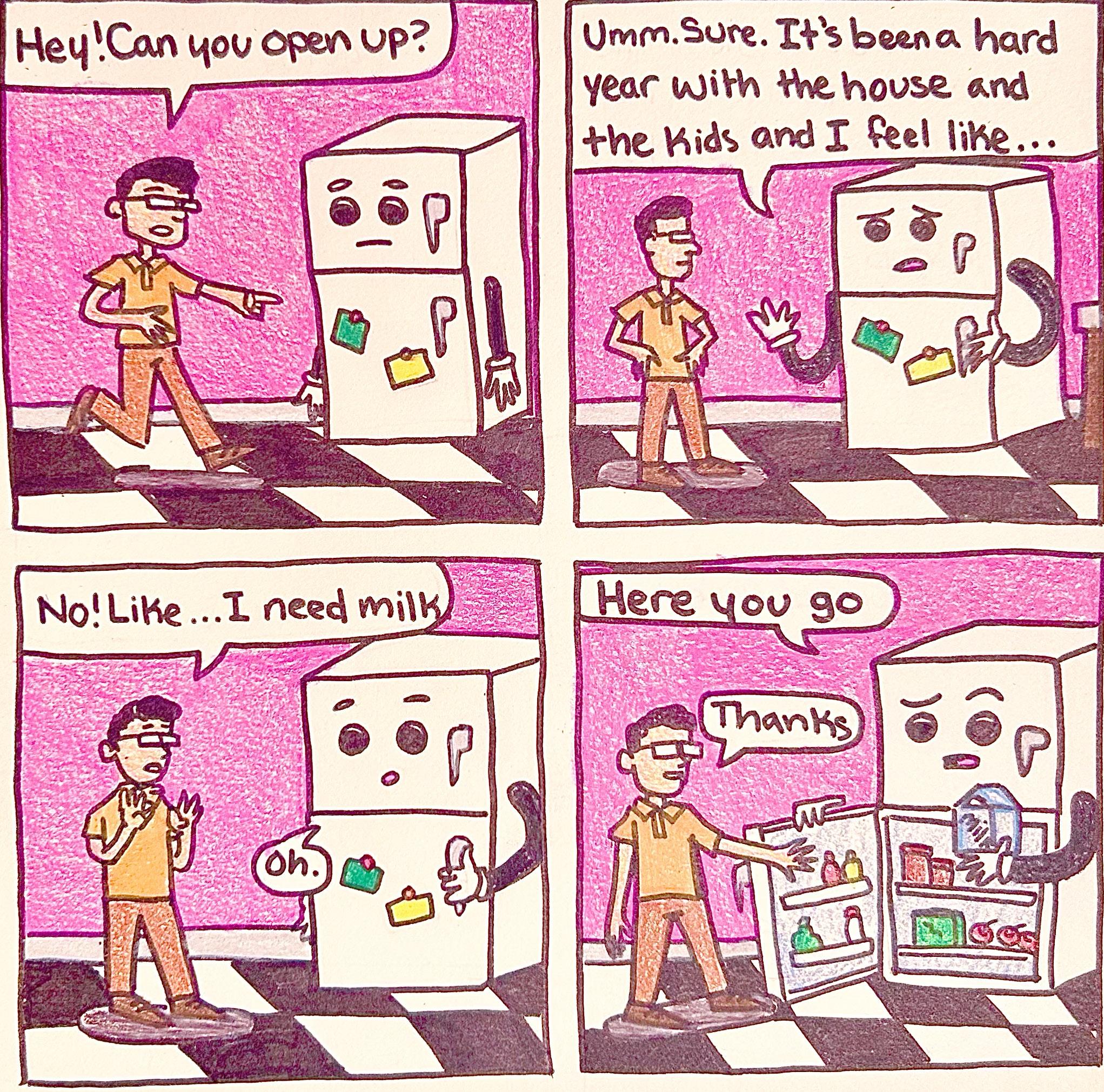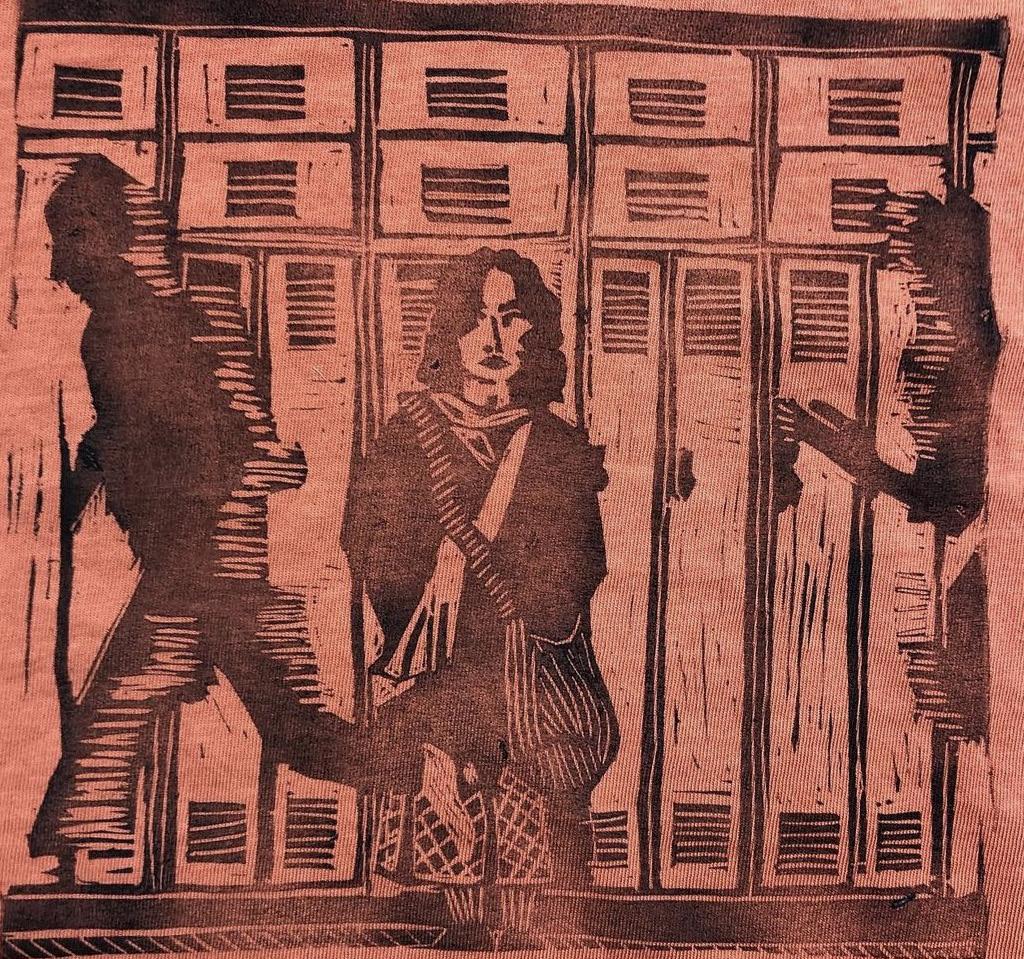




By Finnegan Ricco PHOTO EDITOR
Clad in red shirts, first-years and transfer students packed the seats at the Kohl Center on Tuesday to hear the University of Wisconsin-Madison’s Chancellor Jennifer Mnookin and other speakers welcome the university’s 176th class.
Provost Marshall Charles Lee Isbell, Jr. opened convocation by welcoming new students — 8,500 freshmen and 1,500 transfer students — urging them to seek out “intellectual challenge at the university.”
“You are now part of a long tradition that we call sifting and winnowing,” Isbell said. “That’s an agricultural metaphor we’ve used for over a century to describe scholarly inquiry that pushes boundaries and leads to new insights and discoveries.”
Other speakers challenged attendees to make new connections and step outside of their comfort zone.
Vice Chancellor of Student Affairs Lori Reesor introduced the student affairs theme of “Friendship IRL.” The class of 2028 is the first to have entered high school during the COVID-19 pandemic, and Reesor voiced the importance of connection through an anecdote about a sophomore’s experience with social anxiety.
“Social media and uncertainty on many levels have shaped the ways we interact with each other, yet feeling connected helps us in so many ways,” Reesor said.
While trying new things may be awkward at times, students should learn to find comfort in their identity, “awkwardness and all,” she said. She ended her speech by encouraging new students to push past their apprehension to seek out new opportunities and meet new people.
Convocation comes two months before Election Day, where the majority of new students will be voting for the first time. Amanjot Kour, a senior studying political science and legal studies, spoke to the class of 2028’s situation in her speech about her experience coming to UW-Madison during the 2022 midterms.
“I was really worried that UW wouldn’t turn out to vote,” Kour said. “I quickly learned that UW is a perfect environment for turning our fears into catalysts for purposeful action.”
Kour earned a standing ovation from the crowd as she encouraged new students to register to vote in the upcoming presidential election. Mnookin spoke last, opening her speech by praising the achievements of the incoming class.
“You’re an exceptional group with a plurality of talents, a truly dizzying and impressive range of backgrounds and experiences that you bring here to UW-Madison,” Mnookin said.

In particular, she noted the accomplishments of three students: Angeline Morgado, a freshman who represented Chile at the international UNESCO Youth Forum, Jaden Eikermann Gergorchuk, a freshman who competed in the men’s diving competition during the Summer 2024 Olympics and Steven Dawson, the 2024-2025 Madison Youth Poet Laureate. Later in her speech,

Mnookin revisited the theme of plurality as a mechanism for growth. She emphasized the importance of identity and urged new students to consider different ideas and opinions.
“It’s equally important to disagree with respect for our common humanity,” Mnookin said. “If you can start out with curiosity rather than condemnation and generosity before judgment, you will help us create the community
we all wish us to be.”
Mnookin closed out Convocation by inviting the new students to sing “Varsity” and enjoy a pint of free Babcock ice cream at Memorial Union Students also received a free copy of the 2024-2025 Go Big Read book, “Sitting Pretty: The View from My Ordinary Resilient Disabled Body,” by Rebekah Taussig, along with a free poster of the human ‘W’ they


The Indigenous Cannabis Industry Association and the Wisconsin Tribal Task Force on Cannabis announced a campaign dedicated to the legalization of medical cannabis in Wisconsin.
By Joseph Panzer SENIOR STAFF WRITER
The Indigenous Cannabis Industry Association (ICIA) and the Wisconsin Tribal Task Force on Cannabis announced Tuesday the launch of its Wisconsin Wellness campaign dedicated to the legalization of medical cannabis in the state.
Wisconsin currently stands alone in the Upper Midwest for marijuana legislation as Illinois, Michigan and Minnesota legalized both medicinal and recreational usage of the drug, creating high demand for marijuana purchased in other states.
“Right now, there’s no bill for legalizing cannabis in our state,” Wisconsin Tribal Task Force on Cannabis founder Michael Decorah said during a press
conference Tuesday. “Our citizens are having to make a choice of whether to really commit a crime to go get their medicine and bring it back to the state.”
Decorah and Ho-Chunk District II Rep. Kristin White Eagle stressed the health benefits of medical marijuana during their speeches.
“I have a personal story of my own grandfather, who was a prisoner of war in the Korean War and also did two tours in the Vietnam War, and I feel that this would have been maybe his lifesaver for not only his relationships and his family, but in his own state of mind and wellness,” White Eagle said.
While empirical evidence for the effectiveness of medical marijuana in treating post-traumatic stress disorder is inconclusive, many veterans with the
condition have attested to its benefits in lessening their symptoms, according to the National Institutes of Health (NIH).
The Ho-Chunk Nation decriminalized marijuana on tribal lands in April, yet as a Schedule I drug, its use on Native American reservations is at the mercy of the federal government’s decision to prosecute, according to University of Michigan law professor Matthew Fletcher.
ICIA founder and cannabis entrepreneur Rob Pero believes the importance of Wisconsin Wellness lies in its ability to increase access to medical opportunities for Wisconsinites.
“There’s businesses out there that are really doing the due diligence to create good, viable medicine, and we want to make sure that those busi-
nesses are protected as well,” Pero said. “Whatever sort of legislation does roll out, we are not for criminalization, we are for regulation.”
Cannabis advocates Josh and Megan Lowe, who grow hemp in their backyard as allowed under provisions in the federal 2018 Farm Bill, said using marijuana helps their daughter, Norah, control her seizures as a result of living with Rett syndrome while avoiding negative side effects that occur from the usage of more traditional antiseizure medication.
Research published by the NIH supports the conclusion the usage of THC does decrease the frequency of seizures and has a marked improvement on the health of patients who are resistant to antiepileptic medication.
Sen. Melissa Agard,
D-Madison, joined the ICIA to tout the benefits of marijuana legalization for Wisconsin.
“Legalizing and taxing cannabis in Wisconsin just like we already do with alcohol will ensure that we have a controlled market that is safer for our communities and provide opportunities, health and security for people like Norah and other folks across the state of Wisconsin,” Agard said. “If we have full, responsible adult usage in the state of Wisconsin, we would have well over $160 million in additional tax revenue every single year.”
The Illinois Department of Revenue reportedly collected $417.6 million in taxes from marijuana dispensaries in 2023 while the state of Michigan collected $270 million in the same year.
By Ella Hanley ASSOCIATE NEWS EDITOR
Many students at the University of WisconsinMadison struggle with rent costs and availability, according to a new study commissioned by the university and city of Madison.
Funded by the city and university and conducted by Chicago-based consulting firm Jones Lang LaSalle Inc. (JLL), the study, released Aug. 26, consisted of a survey on UW-Madison students and a separate analysis of the Madison housing community. The university distributed the survey to 46,000 undergraduate and graduate students, and 4,401 students responded.
Students face many challenges in the search for campus living. Factors like an increasing rate of non-student residents, competitive fall leasing periods and expensive rates put pressure on students.
When looking for housing, students prioritize proximity to campus and cost. The average UW-Madison student pays approximately $1,723 per month for housing, but “affordable” student rent was defined at around $980 per month, according to the study. These rent prices are only found on older properties, many of which have been around for 20 or more years, according to the study. Other students lower their costs by sharing a bedroom with someone — roughly 27% of students surveyed share a bedroom, and over half said the reason they’re sharing a room is due to cost efficiency.
The percentage of students sharing a room at UW-Madison is significantly higher than those of other universities (most are around 10%, according to the study).
The study also found that sharing a bedroom shaves off about $100 on monthly rent.
The housing market in Madison is particularly unique due to state Capitol proximity, the downtown atmosphere and its location on a narrow isthmus. For a college town, Madison’s housing market circumstances are unique because both college students and young professionals are drawn to the area, which limits the amount of space available for students.
The fall timing of the leasing schedule also creates inconveniences, especially for first-year students who
don’t have time to understand the market, according to the study. For transfer and graduate students, the pressure of finding housing within the small window of time between their admission decisions and the academic year is high.
The Madison Plan Commission met Aug. 26 to discuss the results and suggest methods of achieving more affordable housing on campus.
The consultants told the university to build more oncampus housing, as living on campus is one of the most affordable options for students. UW-Madison’s newest residence hall, Leopold, opened in 2013.
“University Housing has been actively working with the Universities of Wisconsin and our state partners to pursue options that would enable
us to house all students who desire to live in campus residence halls,” said Associate Vice Chancellor Jeff Novak, who leads University Housing at UW-Madison. “We are trying to move this process forward as quickly as possible.”
The survey also recomme nded the university continue to find ways to help students understand Madison’s unique housing market. University Housing created an Off-Campus Housing Services office last year to help students find off-campus housing.
“We now know exactly what causes local housing market trends, the type of units the city needs to focus on building and how to better educate students on what currently exists,” District 8 Ald. MGR Govindarajan said in an Aug. 27 statement. “Students consis-
tently expressed not knowing enough about the housing market in both study groups and surveys, it falls on the University and City to provide the resources and educate our community.”
Additionally, the survey noted that UW-Madison helps many students offset expenses that come with being a student through financial aid initiatives that include food and housing. These include Bucky’s Pell Pathway and the BANNER program. Additionally, the commission recommended that the Common Council make zoning changes and tax incentives for developers who are currently building new units. While housing availability is competitive and limited, the market is expected to thrive in the upcoming years, and the survey predicted that demand will continue to increase.

By Clara Strecker and Sreejita Patra COPY CHIEF AND SENIOR STAFF WRITER
MILWAUKEE— Democratic vice presidential nominee Tim Walz delivered remarks to union members of the Milwaukee Area Labor Council, AFL-CIO, addressing the key Democratic voting bloc Monday at the city’s annual Laborfest celebration.
As a former union member, Walz spent two terms as Minnesota’s governor focusing on unions, strengthening protections and ensuring paid leave for workers while also limiting union-busting. During the event, he contrasted his platform with that of former President Donald Trump, whose administration blocked overtime pay for workers with 40-hour work weeks or under.
“If people put in an honest day’s work, they should receive an honest day’s income,” Walz said.
“[Trump] is a guy who supports so-called ‘right to work’ laws that deprive unions of the funds they need. ‘Right to work’ means less money, dangerous situations and no pension.”
Walz emphasized Vice
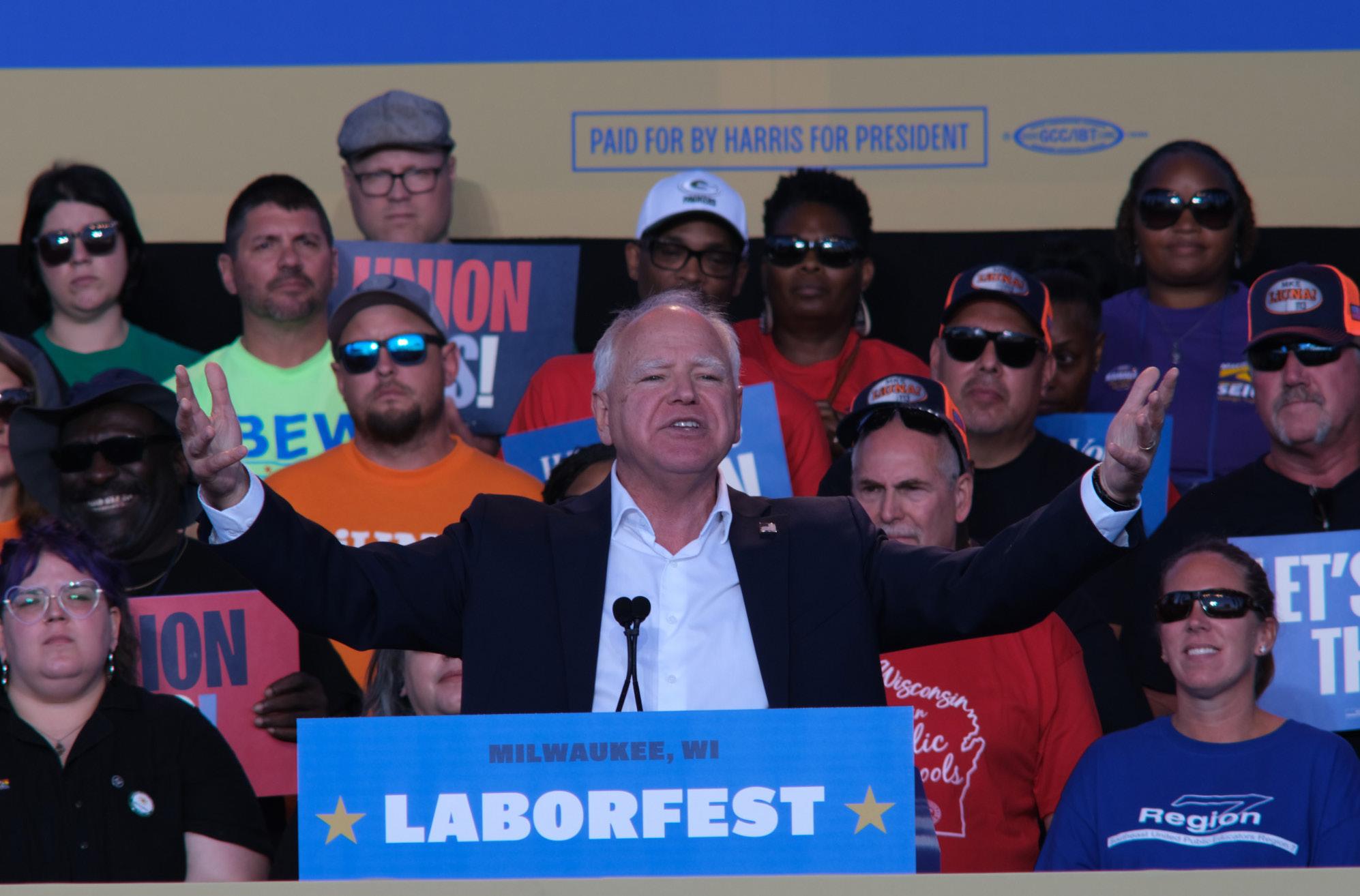
President Kamala Harris’ history as California’s attorney general, where she sued banks for mismanaging pension funds and redelivered the money back into people’s pension funds. Under the Biden
administration, Walz noted Harris was the deciding vote on the pandemic-era American Rescue Plan Act, which provided stimulus checks to working people and extended unemployment benefits.
“It was Vice President Harris and President Biden that protected over 1 million workers’ pensions and retirements,” Walz said. “When we win this election, we’ll have your back just like you have our back.”
Walz said a Harris-Walz administration would sign into law the Protecting the Right to Organize (PRO) Act, which would expand labor protections for unions and make it easier to collectively bargain. He also touted the ticket’s commitment to paid family and medical leave, gun control and abortion access.
“If you want [politics] in your exam room, bedroom and labor hall, then step back,” Walz told the crowd. “But if you want to make sure that we have a government that serves the people, whether it’s labor and middle class rights or having corporations pay their fair share, we need you on the team.”
The visit marked Walz’s first time back to Wisconsin since receiving the Democratic vice presidential nomination. Walz last visited the crucial swing state on Aug. 20 when he joined Harris at Fiserv Forum in Milwaukee for a campaign rally held congruent with prime time programming for the Democratic National Convention.
By Jenasea Hameister
STAFF WRITER
Whether it’s romanticized in movies, read in books or seen while walking downtown on State Street, drinking alcohol is a stereotypical norm on many college campuses, including The University of Wisconsin-Madison.
As classes resume this fall, so will many other social events that involve alcohol, such as Badger football tailgates, Lily’s Classic and the Mifflin Street Block Party.
Roughly 47% of UW-Madison undergraduates drink at high-risk levels, according to the University of Wisconsin-Madison’s University Health Services (UHS) website.
Recent UW-Madison graduate Mike Zande told The Daily Cardinal he does not think UW-Madison needs to change its drinking culture.
“Some of my favorite memories came from the [drinking] culture UW-Madison has, and I don’t think those memories would be the same without that [drinking] culture,” Zande said.
This sentiment rings true among
other recent graduates like Elena Moore and Seth Petersen, who graduated in 2024. Moore told the Cardinal that while the drinking culture is a defining characteristic of UW-Madison, “to say it’s more unhealthy or counterproductive than at other universities is false.”
“Drinking is a big part of most college cultures, and I think that the drinking culture at this school is just more of a testament to our shared spirit of celebration of hard work and love for the community around us,” Moore said.
Petersen expressed there are opportunities to attend non-drinking events on campus.
“There’s plenty of avenues for people not to drink if they don’t want to, and I think that resources would be better spent educating people on safe drinking than trying to change the culture,” Petersen said.
Each student said drinking culture at UW-Madison has never made them feel unsafe.
UW-Madison’s Police Department’s Downtown Liaison Officer Diego


Lema Hernandez told the Cardinal UWPD sees themselves as educators, not just enforcers.
“There is a drinking culture involved with all college students, not just UW-Madison. And will we ever stop underage drinking? No,” Lema Hernandez said. “But what we can do is encourage the safe consumption and the responsible consumption.”
Lema Hernanez said UWPD takes a different approach to policing, which focuses more on behavior. If UWPD sees a student walking out of a bar that cannot carry themselves on their own or looks incapacitated, that can draw concern among officers, leading them to approach the student, he said.
Lema Hernandez said the Medical Amnesty Through Responsible Decisions Program has been a “major success” to UWPD’s approach to underage drinking. This medical amnesty program allows students to call UWPD for medical assistance if their friend is incapacitated from alco-
hol or drugs without the fear of punitive consequences.
Lema Hernandez said UWPD wants to ensure the safety of students and the UW-Madison community.
“Alcohol tends to be an enhancer for other behavior, whether that’s property crime [or] stealing something that isn’t yours to more serious crimes like fighting or sexual assaults,” Lema Hernandez said. “It’s so concerning to law enforcement to understand that what somebody does with alcohol in their system compared to something they wouldn’t do is staggering.”
The largest challenge UWPD faces is trust from the student body.
“When we talk about underage drinking specifically, students sometimes think that we’re out to get them,” Lema Hernandez said. “The responsibility is up to [students] and if they choose to [drink], now they’re at least more informed of what could happen, instead of being surprised by police contact because they didn’t know.”
Singing,distributingnewspapersandmore“expressiveactivities”couldbebannedwithin25feet ofuniversitybuildingsundernewprotestguidelinesannouncedaheadofthefallsemester.
By Noe Goldhaber COLLEGE NEWS EDITOR
The University of Wisconsin-Madison’s new protest policy may be unconstitutional, a constitutional law expert and ACLU of Wisconsin lawyer told The Daily Cardinal.
UW-Madison updated its protest policy Aug. 28 to include restrictions on “expressive activity” within 25 feet of university facility entrances, size limitations for signs in buildings, specific sound amplification restrictions and restrictions on protest activity during select times on campus areas.
Although the policy isn’t trying to limit “individuals speaking directly to one another” such as conversation, free speech and constitutional law expert Howard Schweber said a conversation between friends, the distribution of newspapers or pamphlets, singing or wearing political merchandise could all be prohibited within 25 feet of UW-Madison facility entrances.
Schweber said the university limiting “expressive activity” within 25 feet of building entrances is “extremely problematic, clearly unconstitutional” and “begging to invite some judge to strike them down.”
Tim Muth, senior staff attorney at the ACLU of Wisconsin, agreed that the new policy is “vague and illdefined, and could infringe on perfectly constitutional First Amendment conduct” in a Wednesday statement.
“The restrictions are unclear, making it difficult to distinguish between what kind of activity is permitted and what is prohibited,” Muth told The Daily Cardinal. “Constitutional protections do not end when approaching a campus building. UW-Madison should be an institution where free expression and an open exchange of ideas are valued and protected.”
In a statement to the Cardinal, UW-Madison spokesperson John Lucas said the university worked with legal counsel to protect free expression and meet legal requirements.
“While we respect that there can be differences of opinion in the complicated area of freedom of expression, we believe that we have crafted a policy that complies with both the Constitution and the First Amendment, as well as helping us meet our obligations under Title VI,” Lucas said.
UW-Madison defines “expressive activity” as activities protected by the First Amendment including “speech, lawful assembly, protesting, distributing literature and chalking” in its updated policy.
“This rule suffers from massive overbreadth. It cov-
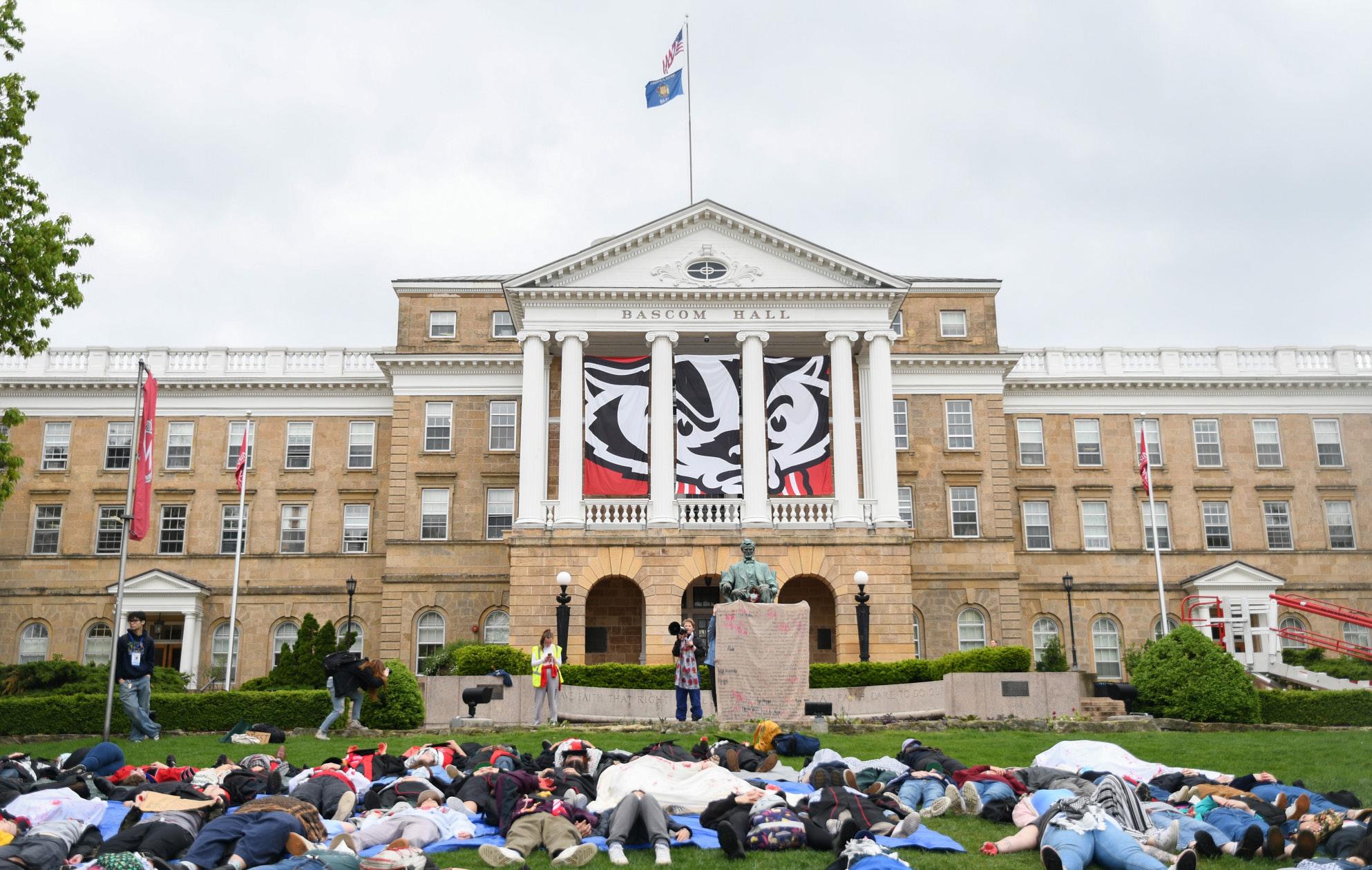
ers an enormous and almost incalculable amount of First Amendment-protected expression in ways that have nothing to do with ensuring access to university buildings,” Schweber said.
Under section 2 D of UW 6013, expressive activity, including protest within 25 feet of UW-Madison building entrances, is the focus of limitations, but the rule does not explicitly protect other forms of free speech.
“In the First Amendment context, we usually distinguish between speech and expressive conduct. You can have rules limiting expressive conduct that go much farther than rules that are allowed to restrict actual speech. But this rule applies to actual, what’s called pure speech — people talking,” Schweber said.
UW-Madison is allowed reasonable “time, place and manner restrictions” on free speech and protests, but Schweber said the vagueness of Section D makes it impossible “for students and others to have any idea what is and is not allowed” within 25 feet of UW-Madison buildings.
UW-6013 Section 2 DII also gives the UW-Madison Police Department the ability to increase the mandatory distance where expressive activity is banned beyond 25 feet to “allow access to university property or to protect the safety of individuals or university property.”
“That means UWPD can literally shut down Bascom and Library Mall completely on the basis that something is happening that they think threatens some piece of prop-
erty,” Schweber said. “That’s a remarkable and excessive authority to constrain First Amendment protected expression without anything like an adequate justification.”
Section 2 F of UW 6013 prevents obstruction to university buildings, a plausible goal of Section D, according to Schweber. Lucas confirmed the goal of Section 2 D was to ensure building access and “to keep passageways clear.”
Schweber said this makes Section 2 D even harder to defend because it is not the “most narrowly restrictive means” to prevent obstruction of university buildings.
Muth agreed that “since other parts of the policy forbid blocking entrances to buildings, this new section appears to be designed solely to limit speech without a compelling reason.”
“I think that’s a perfect illustration of how if you write a rule carelessly, a perfectly legitimate policy goal can lead to absurd results,” Schweber said.
Lucas said the intent of the new Expressive Activity Policy was to “help students, employees and campus visitors better understand their rights and responsibilities.”
When asked about possible restrictions in the 25-foot zone, including the distribution of newspapers or singing, Lucas said “the policy recognizes that engaging in expressive activities is a fundamental part of the student experience and outlines reasonable time, place, and manner restrictions, such as the 25-foot restriction, that work in tandem to help prevent concerted activities from obstructing or interfering with campus operations.”
Student newspaper distribution raises concerns over viewpoint discrimination Distribution of the Cardinal and The Badger Herald, which currently occurs at newsstands near UW-Madison facility entrances, is an example of expressive activity currently banned by this rule, Schweber said. Lucas did not immediately comment on whether distribution of campus newspapers could continue within the 25-foot zone and later said it was clear the policy would not prevent the distribution of newspapers or conversation “inside buildings.”
“One of the problems of the rules like this is that, if you’re the university police, you’re going to say, ‘look, we’re not going to apply this rule in a stupid way, we’re not going to prevent people from distributing The Daily Cardinal, we’re only going to prevent people from distributing leaflets that say, ‘Hunter Biden belongs in prison,’” Schweber said. “But that becomes a viewpoint discrimination. You’re not allowed to have rules like this and apply them only against certain expressions and not others.”
UW-Madison must enforce protest policies in a “content neutral” manner, meaning they cannot distinguish how they enforce restrictions on speech based on the content.
Schweber said in order for the policy to be enforced in a neutral manner, the university must place a ban on student newspapers and “every other printed material within that 25-foot radius.”
Schweber said “chilling effects” can occur when limitations on free expression are
too vague, such as this policy. Chilling effects refer to unintended over-deterrence of free speech, including by self-censorship.
“In order to avoid getting into trouble, people engage in self censorship,” Schweber said. “To avoid getting into trouble, the smart thing to do is just stop talking when you get within 25 feet of an entrance, which is neither the intention of the rule, nor an acceptable rule, if that were the intention of it in the first place.”
The recent protest restrictions followed active pro-Palestine protests in the spring, including during a 12-day encampment on Library Mall.
“Universities have gotten in trouble last year, both for suppressing pro-Palestinian speech and for suppressing pro-Israel speech, so it can get complicated,” Schweber said. “The thing a university has to do is keep sight of basic First Amendment and academic freedom principles.”
A group of UW-Madison students facing disciplinary proceedings for their role in the pro-Palestine encampment previously shared a statement with the Cardinal accusing UW-Madison of attempting to “silence students and staff who have stood in solidarity with Palestine” in their efforts to penalize protesters.
Indiana University Bloomington enacted similar restrictions on expressive activity, including restrictions on expressive activity between 11 p.m. and 6 a.m. The ACLU of Indiana filed a lawsuit challenging the policy Thursday.

By Marco Lama STAFF WRITER
Tony DeSalvo refers to The Stuffed Olive, Double Tap Beercade and Roxxy as the “perfect night out.” Open for business since August 12 on the first floor of the oLiv apartments at the corner of State Street and Gorham Street, the bars offer a wide range of experiences in one location.
“We picked Madison because it has the best of all worlds,” DeSalvo, CEO of the three bars’ parent company Harmonic Hospitality Group, told The Daily Cardinal. “You go four or five blocks this way, and you’ve got the campus. You go four or five blocks that way, and you’ve got the capital.”
At The Stuffed Olive, a mostly traditional cocktail bar, the space is brightly lit, and the music is calm and quiet. The menu offers homemade flatbreads, tapas spreads and more than 100 unique cocktails.
DeSalvo envisions groups of friends or coworkers starting their night here.
“Here, you can start a little lower key,” DeSalvo said. “It’s comfortable, the music is a bit more mellow, we have a menu of easy, shareable foods.”
After spending some time at The Stuffed Olive, DeSalvo imagines patrons migrating next door to the Double Tap Beercade for a change in atmosphere.
In the much more energetic space, rows of arcade games line the walls and fill the floor, with games ranging from Pac-
will continue to expand the number of arcade games they have available and hopes to host gaming events, such as a pinball league. The space also has a bar serving fresh pizza and drinks.
“Here, you’re gonna play some games. Maybe until 8:30 or quarter to nine,” DeSalvo said. “Why? Roxxy.”
At Roxxy, bar goers are thrust into a new environment themed around music and pop culture through the ages. Lining the walls around the dining area and bar are photos of pop icons like Freddie Mercury, Mr. T and Gwen Stefani. Instruments hang from the ceiling, and vintage handpicked cassette tapes wallpaper structural columns from floor to ceiling.
“The best way to describe Roxxy is as an entertainment venue that pays tribute to all music,” DeSalvo said. “You’ll hear music from the ‘60s all the way to modern day. It’s also multi-purpose.”
Roxxy’s main seating area is large, featuring a stage, DJ booth and full bar. This is where DeSalvo imagines people will finish their night with a live entertainment experience. DeSalvo said he will use the space to host bands, comedians, DJs, private events and potentially even theater. Roxxy will host its first live show — The Spazmatics — on Sept. 18 and 25.
Taken together, DeSalvo
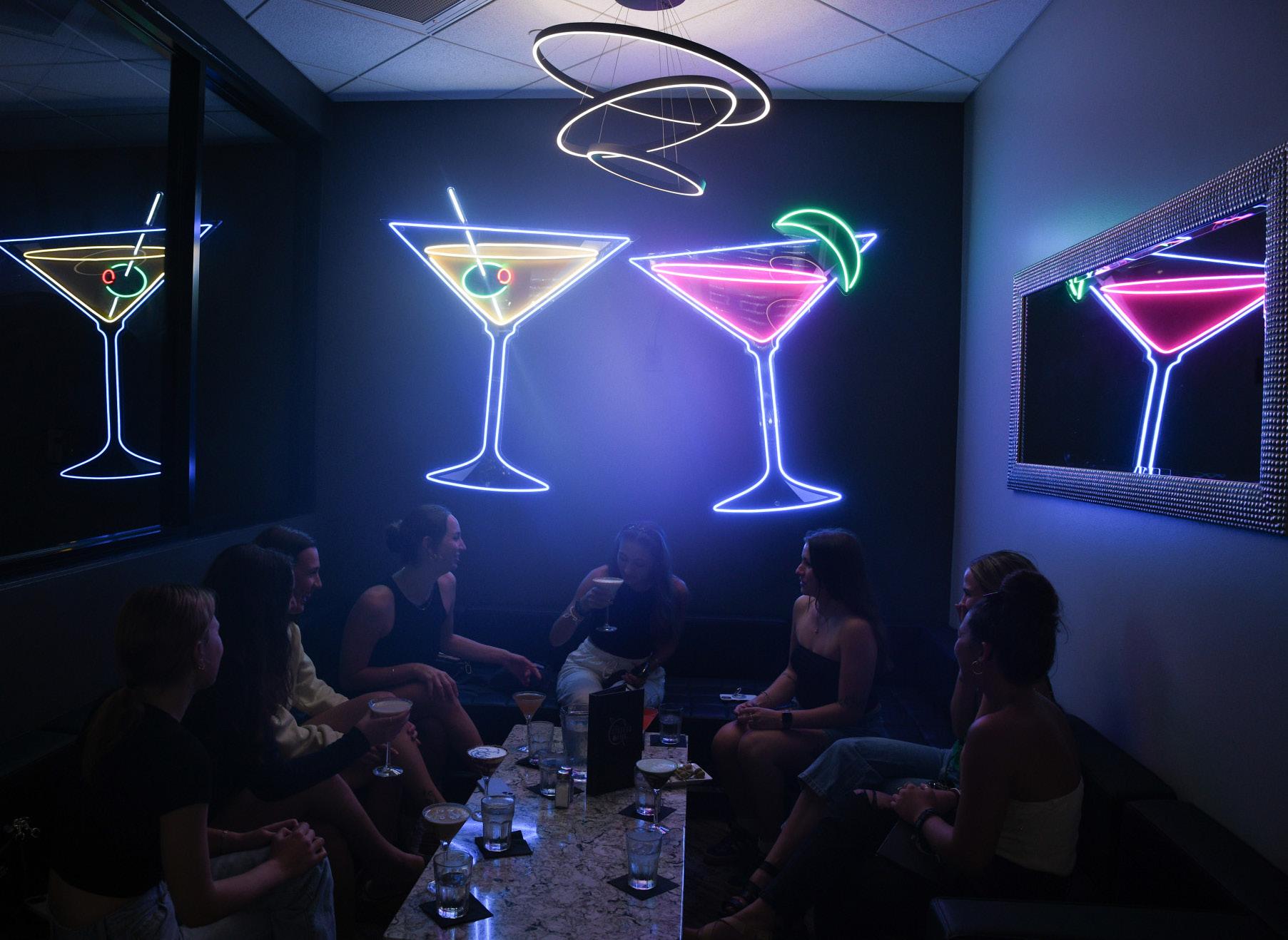
said the three neighboring bars contribute “to that perfect night out.”
“Rather than bar-hopping, you can stay here the entire night,” DeSalvo said.
Making an impact
Originating in Cedar Falls, Iowa, Harmonic Hospitality Group has nine locations across Iowa and Nebraska. But their Wisconsin debut comes with challenges.
With large housing companies like Core Spaces, the owners of the oLiv apartments, building unaffordable apartment buildings and the increase in larger businesses leaving local owners stressed, there is concern chains will push out smaller businesses.
But DeSalvo said this will not be the case here.
Harmonic Hospitality Group has found a match with Core Spaces and strives to foster relationships with the Madison community, according to DeSalvo. A key component of the relationship is the long-term commitment from both businesses to stay in Madison, he said.
In the early days of construction, DeSalvo and others established lines of communication with surrounding businesses, he said.
“It’s not just an investment in dollars and cents. Organizations like us and Core Spaces want to invest in downtown,” DeSalvo said. “The most important thing is knowing it’s not going to be an overnight situation.”
One of the ways Harmonic Hospitality Group hopes to invest in the area is by bringing new jobs to State Street. DeSalvo hopes to fill over 100 positions, many of them seeking incoming students looking for work. Their website’s career page invites anyone to apply.
The spaces are still in their early days, and this is new territory for the company, but DeSalvo said that if they stay true to their core values, they can have a positive impact on Madison.
“We believe in purpose, caring and learning,” DeSalvo said. “That’s what we want to live by.”
By Mar McKenna STAFF WRITER
While meeting for their weekly coffee, former emergency veterinary technicians and Sun Prairie residents Liz Brey and Heather Wipijewski joked about opening their own cat cafe. After years of work, the duo is weeks away from making that dream a reality.
With a project that allowed them to still work with animals and better their community while serving delectable coffee, a passion the two share, they decided to shift their sights to a calmer environment.
Cat cafes are on the rise, spreading from large cities to suburban areas. A cafe where guests can interact with cats, they often partner with local animal shelters so visitors can meet the animals up for adoption in hopes of finding them a forever home.
After retiring from the medical field in 2021, Brey decided to work in a cafe, a position she found much more relaxing than her veterinary technician work.
“The work got more difficult as I got older,” Brey told The Daily Cardinal. “It got more stressful after the COVID-19 pandemic.”
When Wipijewski retired from the hospital a year later, the pair realized opening a cat cafe “was more than a joke,” Brey said.
Just like that, The Cat’s Brew was born.
As part of their business venture, Brey and Wipijewski visited existing cat cafes in 2022 to see how they conducted business and to build connections.
“We used the opportunity to learn things that would work well in our cafe with our own spin: from checking people into the cat lounge, to menu, to layout of cafe versus cat lounge,” Wipijewski said.
After building a solid foundation of knowledge, they hired a contractor and construction team to remodel the building and complete the cafe.
Building a community in Sun Prairie
For Brey and Wipijewski, opening The Cat’s Brew is not the
final goal. After working with animals and their owners only in emergency situations, they did not get to see the community at its best, Brey said. With The Cat’s Brew, they hope their interactions will change for the better and create a welcome, open and positive environment for all people.
The cafe is designed to be able to exist as a separate entity from the shelter. A person allergic to cats can lounge with a delicious drink or play board games and read books provided by the cafe. Brey and Wipijewski encourage guests to stay a while.
“We want to get to know the people in our community,” Brey said.
Brey and Wipijewski are just as committed to their cats. Their other major goal is to help find cats “forever homes,” Brey said. After staying for a few weeks at Little Orphans Animal Rescue, a partnered animal shelter, cats with the potential to thrive in the cafe’s environment will be sent to The Cat’s Brew.
Brey and Wipijewski will continue to monitor the cats’ behavior after their move to make sure they feel comfortable and safe, they said. The owners will have at most nine cats in their cafe, allowing them to develop personal relationships with their felines, another aspect of the project they are anxious for, Brey said.
“The city regulates the amount of animals you can have based on square footage, so we can have up to nine cats at once,” Wipijewski said. “Owning a business and being responsible for everything is a stressful process. It’s a big undertaking, and it’s all new to us.”
But the two are pushing through all the difficulties they’ve come across to finally make their lifelong dream a reality.
“I’m a cat lady, so that’s my excuse [to work with cats],” Brey said. “It’s a dream come true to open this cafe and continue to help rescue them.”
The Cat’s Brew doesn’t have an opening date yet, but Brey and Wipijewski are aiming for mid-September and will announce it on social media (Instagram, Facebook).

By Alexis-Rose Fischer STAFF WRITER
As summer nears its end, it’s refreshing to reflect on the exceptional Spring Concert by The University of Wisconsin-Madison’s Premier Men’s A Cappella group The Madhatters and the work this group puts into their performances as we anticipate their Fall performance.
The Spring Concert, held April 26, 2024, at the Wisconsin Masonic Center, was a wonderful performance housing 900 audience members MadHatter Will Brzycki gave insight into this special performance.
“This performance was unique, as it was a single, extensive show, while previous concerts consisted of two smaller performances in one day,” Brzycki told The Daily Cardinal.
The downsize in performances led to an upscale of the audience. This speaks to the support The MadHatters garner from the community, Brzycki said.
The group also showcased
entertaining videos during their spring concert. The audience viewed a welldocumented vlog of The MadHatters’ trip to Nashville, Tennessee, as well as a “The Office”-inspired skit centered around the group’s practices.
These creative works added an extra layer of excitement to their performance.
The commitment required to be a MadHatter is substantial.
Rehearsals are held three times a week for two hours each, increasing to three hours as each concert approaches.
The group also holds gigs, interviews and social media campaigns to generate excitement for their shows.
“[We’re] pretty strict on showing up to rehearsal,” Brzycki said.
The rehearsal process is carefully structured. Initially, the group breaks into voice parts to learn their sections, then reconvenes to integrate them. “We don’t even figure out soloists until we have the whole song learned,” Brzycki said.
The setlist featured a diverse
range of songs selected through a collaborative process.
“We keep most songs around for two semesters, with about five to seven new ones each semester,” Brzycki said. The final choices are made by narrowing down a playlist of ideas and putting them to a vote.
After months of hard work, The MadHatters’ spring concert was a success.
Some songs held more challenges than others. Brzycki said nerves were high during “Accidentally in Love,” soloed by Will Bruggeman, due to its recent addition to the setlist, and the added pressure of choreography in pieces like “Dancing in the Moonlight,” soloed by Christian Carter. The amazing turnout in light of these challenges only attests to the commitment and talent of The Madhatters.
Songs like “I Feel Good,” soloed by Jonah Morioka, and “Brown Eyed Girl,” soloed by Alex Schmitz, were crowd favorites, bringing the performers and audience
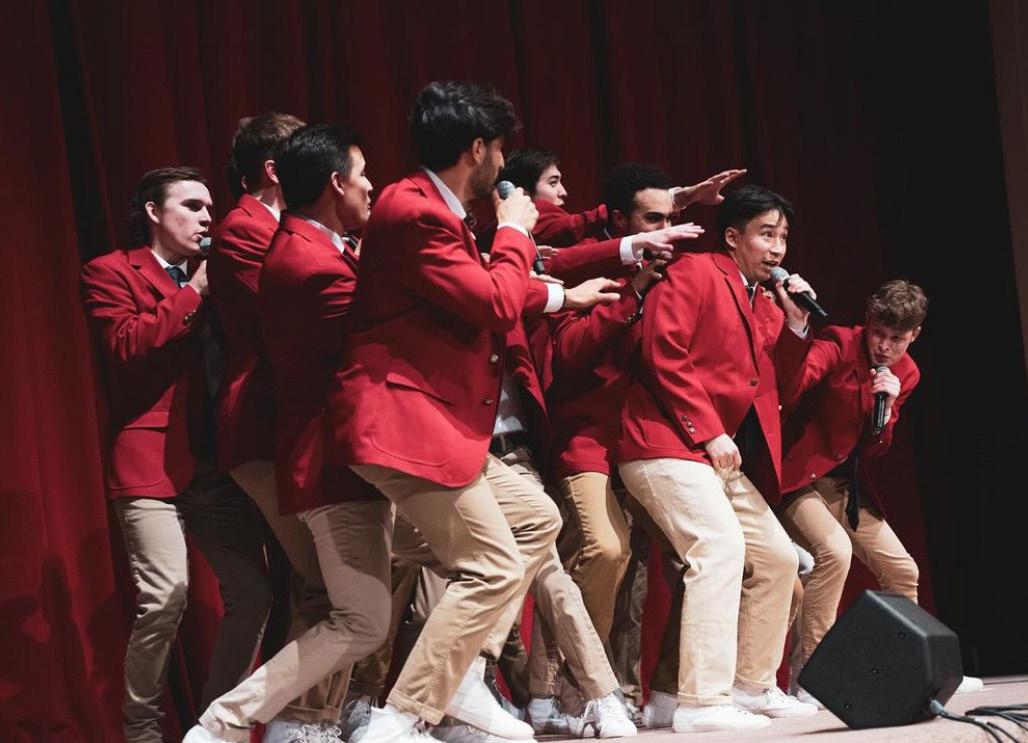
joy. The MadHatters’ “Senior Song,” sung by seniors Asa Rao, Nathan Nguyen and Morioka and Emmett Milligan, elicited a heavy feeling in the concert hall.
“It was a good concert to send the seniors off with. We were all backstage crying afterward because it was such an emotional show. That was pretty rewarding,” Bryzcki said.
Looking ahead, the group is focused on growth and



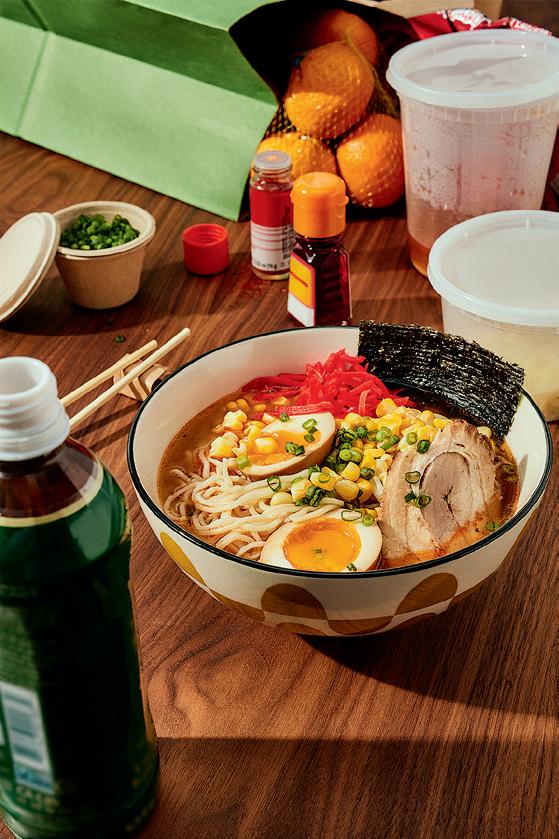




expansion. Brzycki said the Spring concert attracted the largest audience in over a decade. The group has ambitious plans for the future, including more gigs and increased involvement in the community.
The MadHatters will perform their Fall Concert Nov. 23 at Shannon Hall. This upcoming show promises new music and an unforgettable a cappella experience.



By Zoe Kukla, Olivia Ruetten, Francesca Pica, Annika Bereny, Abigail Bures, Hailey Johnson, Bryna Goeking and Alexa Coleman

When my friends and I found our current lease, we knew we had to act fast. We love how close it is to Camp Randall on game days and how fun it is to meet our neighbors. We’ve been enjoying the short walks to coffee shops, record stores, and small businesses owned by people with the coolest stories. I love how Madison can feel like such a big city, but also how it has the charm of a small town. To all the people moving to Madison for the first time, welcome! There’s so much to explore here.
Olivia Ruetten, Life & Style Writer
I have always loved stained glass so much and so when I first thought about decorating my apartment, I knew my treat to myself would be a stained glass panel (this is from Etsy!). I also made sure it was poppies in an homage to my home of California and when the sun rises it shines through my poppies.
Annika Bereny, Senior Staff Writer/Special Pages Editor Emeritus
My roommates and I had no idea this was the view we were getting at our new apartment, but we are so excited! Going into our sophomore year, being close to Camp Randall and getting back into the sports environment of Madison is so special.
Abigail Bures, Sports Writer

By Molly Sheehan SPORTS EDITOR
The No. 3 Wisconsin Badgers volleyball team (0-3) fell in four sets against the No. 1 Texas Longhorns (1-1) in the opener of the State Farm Women’s College Volleyball Showcase at Fiserv Forum in Milwaukee on Sunday.
Reminiscent of December’s Final Four
match-up, which cut the Badgers’ season just short of the National title, Wisconsin looked strong in the first two sets against the back-to-back national champions.
The opening set proceeded with turbulence, marking 16 ties and four lead changes as the Badgers and Longhorns traded points and fought to secure dominance. Wisconsin
displayed their prowess at the net with a block by senior Anna Smrek and fifth-year Devyn Robinson, bolstering the team to a four-point lead. But the Longhorns drove back, helmed by Madisen Skinner’s eight kills, which brought the teams tied deep into the set.
The score rested at 27 points a piece following a kill from Robinson. But the Longhorns took control of the set after a successful challenge by head coach Jerritt Elliott, cruising to a 30-28 victory to claim the first set.
Set two similarly demonstrated a perfect illustration of what to expect from a top-three match-up. Texas broke away for an early 8-4 lead, but the Badgers swiftly responded on defense by stepping in front of Skinner’s attacks at the net. The Badgers continued to break away at the Longhorn’s defense, and a strategically placed tip from outside hitter Sarah Franklin put the Badgers up 14-13.
After a challenge by the Longhorns’ coach on a kill executed by the Badgers’ middle blocker CC Crawford that was confirmed, Wisconsin’s momentum shortly ceded. But it just as quickly returned as Wisconsin took the second set 25-23 to tie the game.
Despite their early prowess, the Badgers collapsed as they entered the second half
of the game. Skinner continued to trouble the Wisconsin defense, struggling to read and pursue the All-American’s hits.
The third set marked a change in the Badgers’ momentum as they struggled to keep up with Texas’ depth in transition. Although Wisconsin fought early to make it a two-point set with back-to-back kills, Texas responded by forcing a six-point that grew as the game progressed. A service ace from Jenna Wenaas closed out the set 25-15 and locked down the lead for the Longhorns.
Wisconsin collapsed in the fourth set despite efforts by Franklin, the 2023 Big Ten Player of the Year. The outside hitter saw three straight kills that pulled the Badgers to the trail of the Longhorns, 5-6, before Texas rattled off back-to-back points, rendering Wisconsin out of contention.
The Badgers failed to find ground in the fourth set, unable to fight against the Longhorns’ precise hitting. Wenaas’ kill for match point closed out the final set 25-11, marking a 3-1 loss that has left them without a win at the inception of their 2024 season.
The Badgers will head to Waco, Texas, to take on Texas Christian University Friday at 4 p.m.
By Caroline McGartland STAFF WRITER
The basics: The University of Wisconsin-Madison’s new starting quarterback is 23 years old, six-foot-four and weighs 225 pounds. Tyler Van Dyke grew up in Glastonbury, Connecticut and went to Suffield Academy High School. He led Suffield Academy to an undefeated season and a state championship in 2019 and was named the New England prep player that same year.
During the college recruitment process, ESPN rated Van Dyke the number two pro-style quarterback nationally, according to the Milwaukee Journal Sentinel. He became a University of Miami Hurricane in 2021 and voted the Atlantic Coast Conference Rookie of the Year after replacing Emory Williams as starting quarterback. Van Dyke struggled with injuries and inconsistency in his first two seasons but still completed 63.7% of his passes for 7,469 yards with 54 touchdowns and 23 interceptions in three years.
Last season, he completed 65.8% of his attempts for 2,703 yards with 19 touchdowns and 12 interceptions. Van Dyke is fourth on the list of returning passers in terms of yards in college football this season. The improvement over his first two seasons to last year shows how Van Dyke’s passing experience will greatly change the current passing game for Wisconsin.
Offensive coordinator Phil Longo named Van Dyke the starting quarterback for Wisconsin in the middle of August, beating out Braedyn Locke who started three games last season in place of injured Tanner Mordecai. But the gap between Van Dyke and Locke is much closer than last season, when Mordecai was clearly number one.
“As Fick says, we kind of see it as a 1A and a 1B type of situation right now as opposed to a 1 and a 2,” Longo said.
Wisconsin hosted their home opener Aug. 30 against Western Michigan,
bouncing back in the fourth quarter to win. The Badgers were trailing early when their only punt of the game became the biggest play. Atticus Bertram’s punt bounced sideways, hitting a Western Michigan player who was trying to run away from the ball. Wisconsin’s Austin Brown quickly bounced the ball at the Western Michigan’s 20 yard line. This play resulted in a six-yard touchdown run by Tawee Walker, putting Wisconsin up for good in a 28-14 victory.
Van Dyke completed 21 of his 36 passes for 192 yards and had eight carries for 21 yards in his Wisconsin opener against Western Michigan. But he also fumbled the ball, allowing Western Michigan to take the lead with 14 minutes left in the game.
In his first game back, “Tyler Van Dime,” a nickname he’s trademarked, has shown he can move the ball incredibly well with two 16 yard drives as well as two 14 yard drives. Van Dyke and the Badgers have to work on more explosive plays, as their longest drive was only 17 yards from the line of scrimmage.
“Van Dime’s” multiple years of experience and determination indicate his ability to lead this Wisconsin Badgers team to a successful season.

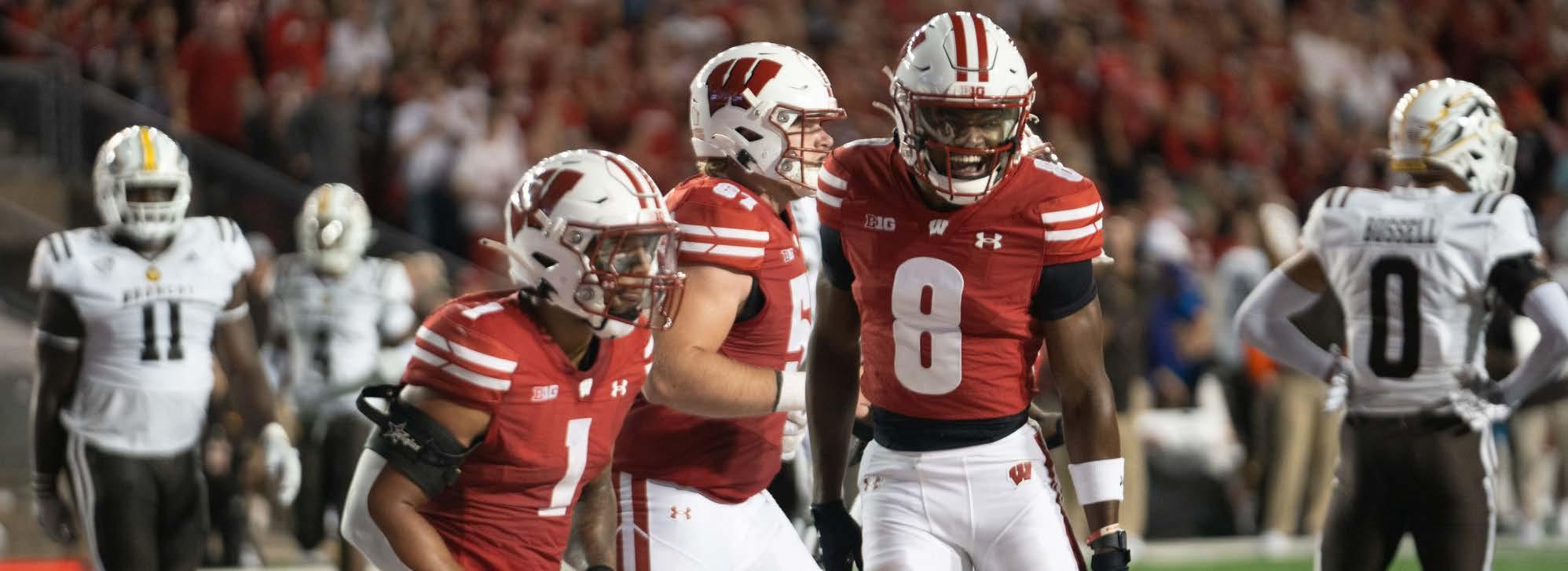
The annual Taste of Madison Food Festival brought Madisonians together through unique food vendors and live entertainment over Labor Day weekend.

By Madeline Wooten STAFF WRITER
The annual Taste of Madison Food Festival was a success this past Labor Day weekend at the Madison State Capitol Square.
With over 80 local vendors, two stages, 10 different music artists and other streets full of vendors, citizens experienced all of the unique flavors Madison has to offer.
The annual festival has been put on by Madison Festivals Inc. since 1983. Madison Festivals Inc. owns and runs The Taste of Madison along with the Madison Marathon. The festival is paid for through beverage sales and sponsors
along with the work of several volunteers, and they also serve as a nonprofit organization that aims to raise money to give back to the Dane County community.
The affordable price point allowed Madison foodies to try all of the different Madison restaurants in the same place without running all over the city. With a free entrance fee and items priced from $1 to $6, it was an affordable option to taste all different kinds of Madison food.
The purpose of the event is to “bring together people, businesses and charities through world-class events that positively impact the community,” according to the
Additionally, the festival works hard every year to give back to the community, with over $2 million in food sales going back directly to restaurants and businesses.
With many unique food vendors, everyone was busy at the two-day-long festival. Lines for vendors would round the square, and popular vendors sold out of their yummy items early into the night.
But food wasn’t the limit for entertainment. People took over the lush greenery around the capital with blankets and chairs as they listened to their favorite artists with full bellies.
Country and rock headliners
Chayce Beckham and Matt Stell performed on Saturday and Sunday, respec-tively. The festival included other activities such as “Playtopia” for families with children and a recharge zone for those who needed to take a break.
While the festival brought the Madison food community together, there was still competition between the food vendors. The 2024 Best of the Taste of Madison contest highlighted vendors in eight different categories including: Appetizer, American, Asian, Dessert, Latin American, Mediterranean/ Caribbean/Jamaican, Southern/ Southwestern and Vegetarian/ Vegan. All these unique categories
brought more business to the winners of the contest. They all showcased the different types of cuisine at the festival.
Although the Taste of Madison is over for 2024, the very popular Dane County Farmers’ Market will continue every Saturday until Nov. 9 as a way to provide the Madison community local produce.
And coming up on Sep. 12 and Oct. 17 from 5 to 9 p.m., the Madison Night Market is another way the city of Madison continues to promote the practice of supporting local restaurants and businesses of different cultures and bring people together with food through distinctive events year-round.

By Olivia Ruetten STAFF WRITER
While scrolling on social media, you’ve probably come across a video on “overconsumption” referring to how people buy and consume goods. If you look around your own room, how many items have you purchased because someone online made it seem like it was necessary, especially as a status symbol?
Originally part of the economic lexicon, overconsumption is defined as the high rate at which people consume resources, such as online products that are commonly cheap and poorly made. This rate is unsustainable, meaning what is being used to produce the goods purchased cannot be easily replenished. In short, we buy so much and so often that the supply chain has a hard time keeping up with our purchasing habits in a sustainable way for the environment. Producing the amount of products necessary to suit the demand of consumers has come with extreme consequences. Companies tend to produce their goods overseas, and while this can make production less expensive and more efficient, labor regulations are often far too lax. It’s not uncommon for manufacturers overseas to employ children for cheap and plentiful labor. Children work long hours in unsanitary and unsafe work environments to meet the soaring demand of products.
Products are sold to customers not by the company, but by its appeal as a symbol of social acceptance. To fit in, customers feel they have no choice but to buy the product, even if deep down they know they do not need it.
This is what is referred to online as “overconsumption core.” The damage of overconsumption is its lack of sustainability. Just because one can purchase what they want, whenever they want, that doesn’t make it environmentally sustainable or ethical.
In addition to the harm caused to the environment, many young social media users have become susceptible to online marketing that seeks to convince them owning products that are popular online mark status and popularity, especially in school.
One elementary schooler reported being bullied in school after they asked for the $40 Stanley tumbler for Christmas and instead got a knockoff product. They said classmates had teased them for not having a “real” Stanley. Younger generations have felt the effects of products becoming status symbols firsthand, proving how the consequences of overconsumption can negatively affect the mental health of social media users, especially children.
Many were fed up with influencers touting collections of products like Stanley tumblers, Amazon “dupes” and “must-have” products. Their solution
was to make videos where they show viral online products and explain why their viewers should not purchase it.
This is also called “de-influencing.” It encourages customers not to buy more, but to be flexible with the products they already possess.
Overconsumption is just one of the
ways that social media fuels consumerism. Content creators make money off products they advertise, like Stanley tumblers or Amazon partnerships. These are not “must-haves,” they’re fads that will pass in a few months. It’s up to us, the consumers, to choose whether or not we fall for the ruse of overconsumption.
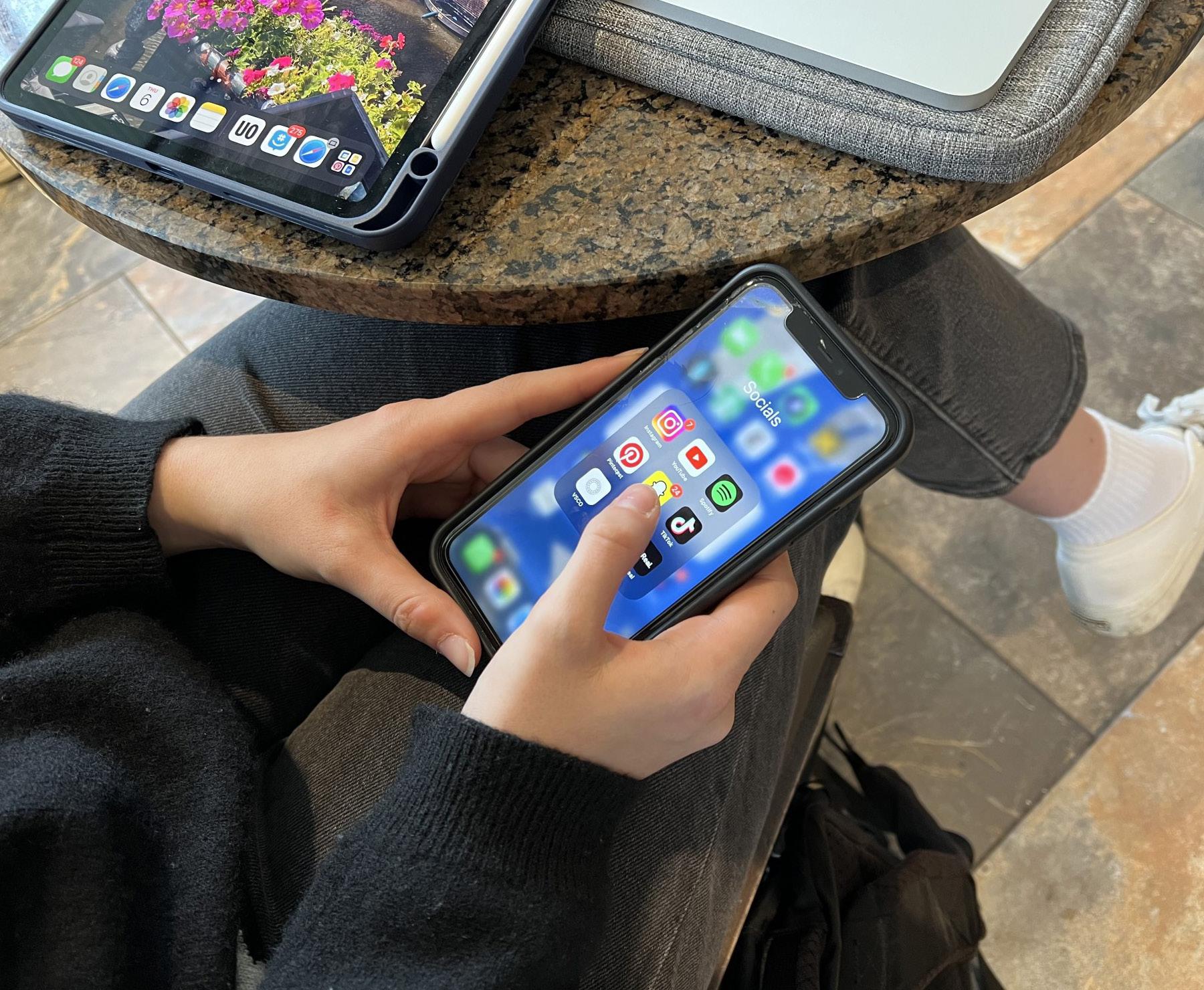
By Marit Erickson STAFF WRITER
Shawn Mendes is the white bread of musicians. Most people recognize his music from açaí bowl restaurants or Urban Outfitters.
The 26-year-old singer is set to release his fifth studio album, “Shawn,” on Oct. 18. Where all his previous work has been marked by a Top 40 radio sound, this new release will feature 12 distinctly different songs.
To many, Mendes is the definition of pop. His singles have dominated the radio for years. His career began on Vine where he showcased six-second pop covers like John Legend’s “All of Me.” When he became the Radio Disney “Next Big Thing” in 2014, it was clear Mendes’ career made it mainstream.
But now, the pop star is pushing 30 and has decided to take an increasingly common route for freshening up one’s sound. Mendes, for better or for worse, is going folk.
We’ve seen it time and time again. Justin Timberlake brought sexy back then later released “Man of the Woods” in 2018. Lady Gaga dominated the club in the early 2010’s. She also sported a pink cowboy hat on the cover of 2016’s “Joanne.” Although “GUTS” is definitively a pop album, Olivia Rodrigo included “girl i’ve always been” on the deluxe edition. The plucky acoustic guitar and sarcastic vocals make the song stand out from her typical production.
But don’t worry, not all pop artists are releasing folk music. Some transitioned to country instead. Beyonce’s “COWBOY CARTER” debuted at No. 1 on the Billboard 200 and broke the record for most sales of an album that year. Post Malone’s “F-1 Trillion,” another recent release,
have to be that
has a feature from probably every notable country artist. He even got Dolly Parton.
Folk and country have historically been synonymous. Is Glen Campbell not folk? Is he not country, too? It all falls under the broad Americana umbrella. Taylor Swift’s transition to folk seemed natural considering her country roots.
So where did the singer-songwriter obsession come from? Why not continue making club hits, songs you can jam to in a mini skirt? Why does everything have to be so serious and brooding?
Think about all the budding folk performers gaining massive fanbases in the matter of a few months. Tyler Childers has had multiple songs go viral on TikTok. Zach Bryan is selling out stadium tours. Leon Bridges is booking festivals like Austin City Limits and Stagecoach.
After Swift’s 2019’s “Lover” lacked the critical acclaim the singer-songwriter drove for, “Folklore” and “Evermore” rejuvenated her career. Folklore won Swift her first Album of the Year Grammy since 2014.
Not only are these artists monetarily successful, they are also critically praised. The historical significance of Americana music grants it validity among older critics.
Americans love folk music the way they love a cowboy. It’s just classic.
Stripped-down acoustics and melancholic chords make an artist sound introspective or poetic no matter what lyrics they’ve written.
Contrast that with Mendes, whose music is the stuff you hear at the mall right when you’re ready to leave. 2019’s “Señorita” feels like our generation’s “We Didn’t Start the Fire” or “Ice Ice Baby.” If the song plays in public, you’re sure to hear a few
sighs of disappointment.
So like many before him, Mendes is looking to shed his long-held reputation and finally be taken seriously. No more music you hear in the background of an Uber.
Perhaps Mendes will manage to utilize Americana to his advantage. Two singles (“Why Why Why” and “Isn’t That Enough”) have already been released with mixed reviews.
“Why Why Why” features a textured guitar, sweeping fiddle and plenty of clapping and chanting. You can almost picture Mendes writing this track while sitting on a log by a campfire. The chorus is catchy and the song builds in a satisfying way.
I actually see myself listening to “Isn’t That Enough.” Its aching chords remind me of Bob Dylan’s “Knocking on Heaven’s Door” or The Rolling Stones’ “Wild Horses.” Harmonica and slide guitar mix with Mendes’ simple harmonies creating a warmth few songs have managed this year.
Therefore, I struggle to decide whether or not this redirection is a misstep. Has Mendes denounced the pop gods, written a new song for white boys to play at their unsuspecting girlfriends? Or is he simply experimenting, as all good musicians should?
I’m not offended by an artist changing over the years. This trend has produced some great work. Rather, I question why artists feel the need to turn to Americana in crisis.
We shouldn’t be using folk as a shortcut to impress audiences. The narrative on what is considered intellectually impressive in music production should shift.
I loathe the idea that pop music lacks intelligence. It takes just as much ingenuity to write and

record a hit like Swift’s “Style” as it does to make the tearjerker “Cardigan.” Writing addictive melodies like Timbaland or Pharrell Williams have throughout their entire careers should be a feat all musicians strive for.
I want my generation to have music we can dance to. If you go to a party in 2024, chances are any pop music played will be from our childhood. The 2010’s had artists like Pitbull, Kesha, Rihanna and Katy Perry at their prime. New pop girls like Charli XCX and Sabrina Carpenter are rising to fill the void, but we need a greater effort.
Gen Z has some of the worst mental health of any living generation. I certainly don’t have the ability to blame that on music, but shouldn’t the saddest generation have more songs that will cheer us up?
Rather than switching genres, maybe artists like Mendes could put all their effort into producing an amazing pop album — an album I can play for my kids one day and reminisce on how much fun I had listening
to it in my youth.
2020’ s “Chromatica” was a much more exciting “I’m back” announcement from Lady Gaga than “Joanne” because we saw her both return to her roots and elevate her content. Even though the album is full of 808 beats, it still has serious messages about Lady Gaga’s life and her struggles with mental health and addiction. Charli XCX’s most recent release “Brat” is undoubtedly a party girl’s dream. Still, look closely, and you see many of its tracks hold a deeper meaning. “Apple” delves into her generational trauma. In “So I,” the artist mourns the loss of a friend. “Girl, so confusing” covers the intricacies of female friendships. I find this integration of lyric and sound far more interesting than “Shawn” because it is unexpected. If Mendes wants to turn to folk for artistic reasons, then he can. But he shouldn’t have to. Musical artists should be appreciated for the intellectualism of the work, whatever genre it happens to be in.
You are more than the media you enjoy: The postpandemic fan culture crisis
By Blake Martin
OPINION EDITOR
Are you a diehard Badger? A “Swiftie”? A “Barb”? “ARMY”? Would you judge someone who wasn’t? Would you try to ruin their life?
As ridiculous as that might sound, changes to internet pop culture in the wake of COVID-19 lockdowns have turned online media discourse volatile. In recent years, journalists and social media users alike have been “doxxed,” harassed, reported to employers and sent death threats by mobs of angry fans for as little as writing articles that “gently criticized Taylor Swift’s Eras Tour.”
This, while alarming on the surface, reveals a deeper problem: internet culture’s ability to blur the lines between so-called “fandom” and identity.
In the last four years, social media and internet culture have become somewhat unavoidable. The majority of U.S. adults have Instagram accounts, and around one third are TikTok users. From shortlived food trends to celebrity cancellations and even social justice movements, the nature of popular content on these platforms encourage users to become
active participants in internet culture.
Unsurprisingly, both TikTok and Instagram reported significant increases in traffic during global COVID-19 shutdowns, with TikTok’s follower base increasing by 75% from January to September of 2020.
For many, the adjustment to social isolation was a difficult one. When March 2020 rolled around, in-person community building stopped. Public spaces like schools, bars and restaurants closed their doors, and any opportunities to see non-immediate family members came with serious health risks, which allowed digital spaces to take their place as a safer, more accessible alternative.
But unlike the majority of physical community spaces, online communities and forums more intensly center on shared interests. From sports to movies, politics, TV shows and music, interest based online communities flourished during periods of social isolation — and for some, these spaces did real good.
With nothing else to do but worry, and wait for things to change for the better, many looked for comfort in the familiar.
Paul Booth, a professor of Media and Cinema Studies at DePaul University, finds that in times of great change, a return to a favorite piece of media “brings a sense of normality” to an “abnormal kind of situation, especially for those people that are socially isolated.”
In turn, participating in the associated “fandoms,” help “form a kind of community,” and one that is “often very tight knit.”
While the benefits of “fandom” culture during lockdown can’t be ignored, we shouldn’t forget about the real harm they can, and have caused in the years that followed. Even the unifying elements of “fandom” culture contribute to that harm.
Platforms like TikTok rely heavily on algorithms that analyze user content engagement attempting to “steer you toward more videos that will keep you scrolling.” When members of an online community decide to engage with content that positively represents their interest, the more likely they are to come across similar content in the future.
At first glance, this might not seem problematic, but the more time fans
spend around opinions praising their favorite media or artists, the harder it becomes to accept dissenting opinions.
In turn, online fan communities essentially function as media-based “echo chambers” that leave little room for disagreement or discourse. Some members of fandoms go as far as crediting artists like Taylor Swift and groups like BTS for “saving their life.”
But this process does more than reinforce positive opinions about pop albums — it can lead to the development of one-sided parasocial relationships and participation in “morally motivated” harassment. When fans rely on media as a form of support and community, average conversations that call into question the quality of an artist’s work have the possibility of registering as personal attacks.
The bottom line is that since the pandemic, fan culture has gone too far.
Virtual pop culture-based communities are important, but it’s time for “fandoms” to separate personal experiences and concepts of identity from the artists they love and the media they enjoy.
A new and contagious strain of mpox has made its way out of central Africa, but the CDC considers the risk of the strain to be low in the U.S. for now.
By Sonia Bendre and Lindsay Pfeiffer STAFF WRITER AND SCIENCE EDITOR
The World Health Organization Director-General Dr. Tedros Adhanom Ghebreyesus declared mpox a public health emergency of international concern on Aug. 14 following the uptick in cases in the Democratic Republic of Congo and the spread of the virus across surrounding African countries.
On Aug. 15, the public health agency of Sweden confirmed that strain Clade Ib of mpox reached outside of Africa to Sweden, where a traveler picked up the virus after visiting one of the countries affected by mpox. Since then, cases have been reported in Thailand and the Philippines, according to the New York Times. At the moment, the risk to Wisconsin and the general U.S. public is very low, according to the U.S. Department of Health and Human Services.
What is mpox?
Mpox, previously called monkeypox, is a virus similar to smallpox, though less severe and less contagious. There are two different strains of the virus, and the current strain is mostly caused by Clade Ib, a mutant of Clade I, according to the WHO. Typically endemic to central Africa, Clade Ib is more severe and more deadly than the genetically distinct strain that caused an outbreak in 2022, Clade II.
“Whether the mortality or death rate would be similar in DRC versus somewhere else like the U.S. is unknown. But, obviously, we have to be hesitant upfront and watch very closely because it does have this increased mortality compared to the other version,” Dan Shirley, an infectious disease physician and medical director for infection prevention at UW Health,

told The Daily Cardinal.
Were the virus to spread, the mortality rate is expected to be lower in the U.S. than in the DRC. Unlike in the DRC, the U.S. Food and Drug Administration (FDA) has already approved use of two vaccines against mpox.
The fatality rate for Clade Ib is around 10% in children and five percent in adults, compared to a fatality rate of one percent or lower in both populations for Clade II. The virus is also more deadly for those with comorbidities such as HIV.
The virus is zoonotic — transmittable from animals to humans — and was discovered in 1958 in a monkey, though monkeys are not the infection source. It was first discovered in humans in the DRC in 1970. It belongs to the Orthopox family, along with 12 other DNA viruses. The family includes smallpox.
“[Orthopox] is a group of viruses that all cause a pox disease, pustules that are on your skin,” Emma Mohr, an assistant professor in the Department of Pediatrics, told the Cardinal. Mohr’s
research focuses on the transmission of Clade IIb mpox from mother to fetus during pregnancy.
Mpox can also be spread personto-person via physical contact, and Clade Ib can be transmitted sexually and through contaminated objects, as well as to a fetus through an infected mother. Those affected can experience a variety of symptoms, including swollen lymph nodes, fever and, most notably, skin lesions, which generally take weeks to heal.
“The skin lesions can be all over your body, including in your mouth and down by your bottom, and can impact your ability to swallow liquids, keep liquids down and stay hydrated. Sometimes the infection is so severe that it infects the lungs and infects the brain, and that’s why people die,” said Mohr.
This outbreak comes on the heels of a 2022 outbreak of the Clade II strain of the virus, which affected 95,000 people across 115 countries, and over 32,000 in the U.S. alone, including 97 in Wisconsin, according to the CDC.
Both Mohr and Shirley agreed there will likely be cases of Clade Ib in the U.S. Whereas the previous outbreak affected primarily sexually active gay and bisexual men, the new outbreak primarily affects children. Around 70% of the now over 20,000 cases in DRC are in children under 15, and case numbers are likely underreported due to limitations in contact tracing, testing and surveillance, according to the WHO.
More than 95% of all cases of the new strain originate from DRC, although the virus has affected 13 countries in total, according to the New York Times. So far, 975 deaths have been reported in DRC alone. Besides vaccines, social distancing can slow the disease’s spread. But some places in DRC, particularly displacement camps, are so crowded that they make distancing difficult or impossible.
“I hope that the global community is able to help intervene now that the WHO has called it a public health emergency of international concern and really help to get medical care and vaccines to these impacted populations in the civil unrest in that area,” said Mohr.
Recently, the WHO Director-General initiated the process for Emergency Use Listing of mpox vaccines. This listing allows companies to submit vaccines for approval and distribution by partners such as Gavi and UNICEF. Although the Emergency Use Listing of the vaccine has been initiated, it has not yet been approved, and the WHO has not officially approved the two available vaccines for use. This complicates the process for vaccines to be transported into DRC — it is estimated that around 10 million vaccines will be needed to quell the virus.
By Nicole Steele STAFF WRITER
T wo University of WisconsinMadison researchers helped Madisonbased biotechnology company FluGen create a new intranasal influenza vaccine candidate.
FluGen CEO Paul Radspinner told The Daily Cardinal he worked on the vaccine for 14 years with the help of UW-Madison researchers Yoshihiro Kawaoka and Gabriele Neumann to create a vaccine that is now in clinical trials with the potential to enter the market in the near future.
The vaccine works differently than the regular intramuscular shots commonly administered each year. Instead of using a killed portion of the flu virus, Radspinner told The Daily Cardinal the intranasal vaccine is used with a portion of a live virus.
“The way the flu virus typically works is it invades the cell, it makes multiple copies of itself, and it spreads out into other cells, and that’s what gets you sick. Our vaccine is missing this key gene that when it goes into the cell, it can’t get out of the cell…so it can’t go and infect other cells and
make you sick,” said Radspinner.
The research Kawaoka and Neumann have been working on for decades involved deleting certain gene components of many other contagious viruses, such as Ebola virus, influenza and even COVID-19.
This research, along with the founding of FluGen in 2008, allowed for the creation of this intranasal vaccine, Radspinner said. The results are promising, with more than 700 subjects in clinical trials ranging from the ages of two to 85.
“We actually did a challenge study where you vaccinate half the group, you give placebo to the other half, and everybody gets infected with flu,” Radspinner said. “What we saw was a dramatic reduction in infections and illness.”
Radspinner also said a nasal spray may have certain advantages over intramuscular vaccines.
“We think vaccinating at the site of infection, where you’re typically going to be infected with flu, creates a much better potential for preventing infection,” Radspinner said.
The clinical trials also tested the use of the nasal spray vaccine in conjunction

with the regular intramuscular vaccine.
The intranasal vaccine paired with the shot may create a greater efficacy at preventing infection, Radspinner said, which will allow those who are over the age of 65 or at greater risk of having more severe influenza be treated with a greater dose of immunity. This may result in less hospitalizations and deaths from influenza each year.
The nasal spray vaccine may also result in a greater amount of immu-
nizations from those who are more afraid of needles, Radspinner said.
The possibility of a new vaccine could soon be reaching the public’s noses in the coming years. Radspinner estimated the vaccine could be out in the market by the 2027-28 flu season.
“We’ve been a part of the University of Wisconsin from the beginning…I can’t think of anything more we could have. It’s been a great place to grow the company and grow the vaccine,” says Radspinner.
From starting new to ending unsure, I’m here to answer all your back-toschool questions and queries.
By Morgan McCormack
BEET EDITOR
Hello and welcome back
Cardinal readers! It doesn’t matter if you are new or returning to the great school of The University of Wisconsin-Madison, you all need the same thing: advice.
Let’s face it, I really am the only person in the world that knows what they are doing. Unlike you all, am I able to navigate any and all situations, I even was able to convince my parents getting a degree in creative writing was a good idea.
Lucky for all of you I am kind enough to share my knowledge by answering your wonderful questions. So, let’s kick off the semester with two questions from readers like you.
Hey Morgan,
I’m a freshman and was super excited to start college. A bunch of my highschool friends decided to go here too, and at first I thought it was a blessing because I would already have a built in friend group. Well, it’s literally been a week and I realized I never want to see any of those people again. At the same time I haven’t really made any other friends, so I’m nervous about cutting them off and being alone. What should I do?
I too hail from a Wisconsin high school that was basically a Madison feeder school. What I’ve learned is you are not supposed to be college friends with your high school friends.

It’s like those shows where the characters are in high school and the first couple seasons are really good. If you’re smart, you end the show there so it can be remembered fondly, but when greedy show producers sometimes send them to college to get a couple mediocre seasons, it ruins the entire way we see the show.
Some shows, and people, are meant to end after graduation.
Being alone is scary, but what’s the alternative? Let’s face it: you probably were only friends with these people because you were trapped in the same building for seven hours a day, five days a week together. You need to move on

and find yourself away from the people you took homecoming pictures with.
Having no friends isn’t even the worst thing that could happen. If you stick with these people, you might just snap one day and do something you might regret. Trust me, that is a lot of money in legal fees. It
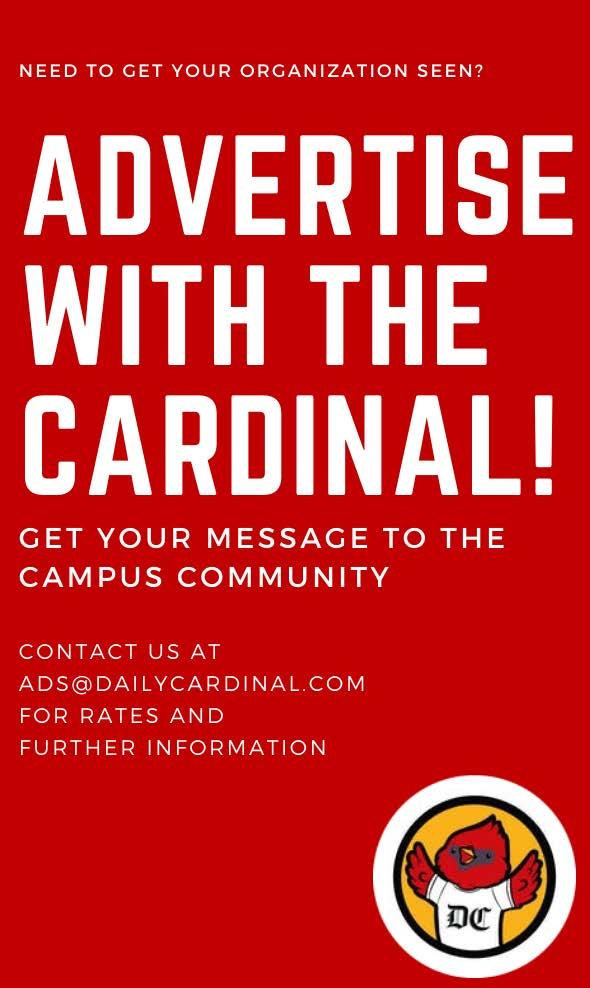
might be better to just distance yourself and find people you actually have something in common with.
Hope this helps!
Hey Morgan,
I’m a senior this year and I’m about to graduate with a degree in computer science. I chose it because I love techie things and thought it was a stable career. Well, now apparently the job market sucks, and I’m nervous about graduating. What should I do?
Listen, I would normally feel bad. The job market is hard and graduating is scary. That being said, having to hear my degree was useless from tech types most of my college career, I feel like this is some kind of cosmic karma. Oh, I’m going to school to become a barista, well pass the almond milk because we’re going to behind that pastry counter together.
However,if you are truly passionate about computer science you should stick with it. College should be treated like it was in the 1800s, minus the only accepting rich white men thing. You go for the pursuit of knowledge and to get your parents off your back about marrying a cousin.
In the end it doesn’t matter since we’re all going to be project managers at Epic anyways.
Hope this helps!







